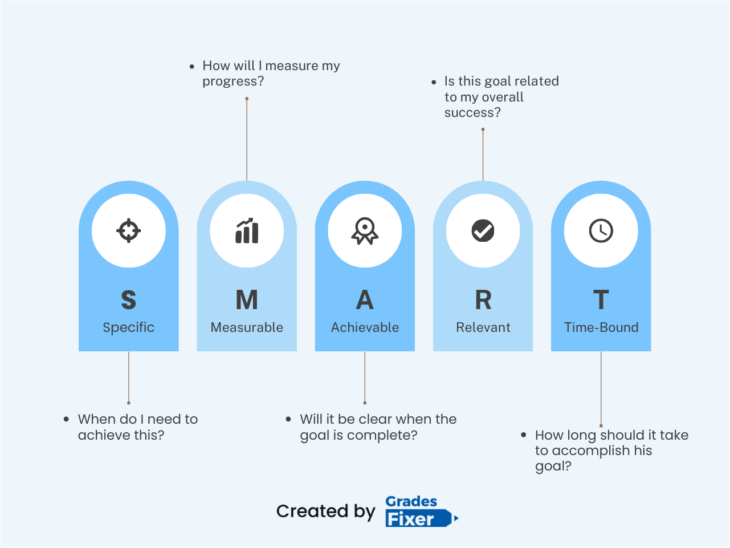Finding academic success can be a tough route to navigate. It’s important to learn time management and set goals for yourself throughout the school year.
Creating specific goals and holding yourself accountable maximize your chances of achieving your goal.
Using SMART Goal examples for students will help you sharpen your skills, keep you focused on objectives, and set achievable goals that show you have made progress.
Table of Contents
ToggleWhat is a SMART Goal?

The SMART learning technique represents a highly effective framework for setting clear and attainable learning objectives. If you want to go through a couple of practical examples of this technique, visit gradesfixer.com.
This methodical approach not only facilitates focused and structured learning experiences but also significantly enhances the ability to track progress and achieve educational goals efficiently. By integrating the SMART criteria into the learning process, educators and learners alike can benefit greatly.
SMART goal is a technique you can use for setting goals and improving the feasibility of achieving them.
The acronym SMART stands for:
- Specific
- Measurable
- Achievable
- Relevant
- Time-Bound
S: Specific
Specific means having a detailed goal you wish to achieve that isn’t broad or general. Simply saying “get better grades” is a vague goal.
You want to set out a detailed or specific action plan that will help you reach your end goal.
For Example:
Instead of saying “Get better grades,” you could say “Increase my GPA in English from a 3.0 to a 3.5 by submitting extra credit assignments.”
Now you hold yourself accountable by setting goals that are specific and give you responsibility.
M: Measurable
Simply setting a goal and waiting for it to be achieved is unrealistic.
By setting a time in which you wish to accomplish your goal, you can not only track your progress along the way but also create a sense of urgency in completing the objectives.
For Example:
You could improve the previous example by saying, “Increase my GPA in English from a 3.0 to a 3.5 by submitting 1 extra credit assignment a month.”
You now know you must submit an assignment each month. This holds you accountable and lets you track your progress.
A: Achievable
You want to make sure you are setting goals for yourself that you consider to be realistic and achievable goals. Consider whether you have the knowledge, capability, and resources to complete this task.
Is it a realistic goal that you can achieve in the given timeframe?
For Example:
With the SMART Goal, increasing the GPA by .5 points may be unrealistic.
Instead, you could say, “ Increase my GPA in English from 3.0 to 3.1 by submitting 1 extra credit assignment a month.”
Now you have a goal that is more obtainable and should be easier to achieve through your course of action.
R: Relevant
Question how this is a relevant goal to you. Make sure that the course of action pertains to achieving your goal.
Maybe you wish to improve your grades in English because you want to take a class for Advanced Writing, but your grades aren’t high enough to be accepted.
If you’re looking to improve your grades in English, don’t stay after school with a math tutor or join the chess club.
In the previous example, the goal plan is relevant to achieving an improved grade in English, using a specific and realistic action plan.
T: Time-Bound
Create a detailed time frame with a deadline to complete your goal. This allows you to track your progress and pace yourself properly to complete your goal on time.
For Example:
Instead of saying, “Increase my GPA in English from 3.0 to 3.1 by submitting 1 extra credit assignment a month.” Try changing it to “Increase my GPA in English from 3.0 to 3.1 by the end of the term by submitting 1 extra credit assignment a month.”
Now you know that for the next 2 or 3 months you must submit your assignments and increase your grade by the end of the term.
By utilizing all of the Smart criteria, you go from having a vague goal with no real end or direction to a detailed realistic action plan that you know you can achieve within a given time.
Why Do Students Need SMART Goals in 2024?
Students need SMART goals because they teach skills necessary for the future.
As students progress in their academic careers and venture into the real world, they’ll be met with less supervision along the way.
SMART Goals instill in students a sense of urgency, teach time management, and help to stay on track for academic success. These specific goals create accountability and act as a guideline to reaching goals that have been set.
It’s also important for students to learn that they must self-reflect to see where their course of action will bring them and how they can tweak it to change their course and end result.
Below are some SMART Goal examples for students.
SMART Goals Examples For College Students 2024

Attending college can be incredibly challenging for many students.
Between budgeting, studying, and attending lectures, it can feel like you’re failing at everything and always trying to catch up.
Here are a couple of SMART Goal examples for college students.
Example: Find an Internship
I want to gain experience in my field so I can join the career I’m pursuing. Therefore, I will apply for 2 internships a week for the next 6 months until the school year ends.
S: Taking direct action to attend an intern program will help me gain experience in the desired field.
M: This goal can be tracked monthly and by the number of applications.
A: This goal can be achieved by keeping the number of applications lower, and there are resources provided on campus to help, as well.
R: Many fields of work require prior experience before hiring. Attending an internship will help me gain the necessary skill and experience.
T: This goal is time-bound because it must be completed by the end of the year.
Example: Mental Health
In order to improve and maintain my mental health, during the school year, I will dedicate 1 hour a night to a self-care routine, be more transparent with professors when I need help, and call home at least twice a month, so that I am in my best mental state to do well during the school year.
S: This course of action, using support systems and caring for oneself, should improve overall general mental health and help maintain a balance.
M: This goal can be tracked daily and will be continued through to the end of the school year.
A: Finding time to call home or for self-care is possible. Professors can be understanding and getting an extension on a deadline or assistance with an assignment is as simple as sending an email asking for help.
R: It is vital to be in a good state of mind to do well in your academic career and personal life. Having a support system can get you through hard times. It’s important to take care of yourself.
T: This goal is to be worked on and completed throughout the school year.
SMART Goals Examples For High School Students 2024

Although there is a little more supervision in high school, time management and prioritizing responsibilities may be a lot to handle.
High school is an important part of shaping where your academic career will go and ultimately how your career and personal life will turn out.
It’s important to keep yourself on track and set goals for yourself that will help you achieve your dreams.
Take a look at these SMART Goal examples for high school students.
Example: Increasing Grades
Increase my grades by next term in biology and algebra by retaking my most recent tests within two weeks, studying 30 minutes a day, and attending after-school classes twice a week to avoid being kicked off the football team.
S: Focusing on classes and taking steps to improve grades will avoid getting kicked off the team.
M: This goal can be tracked daily and weekly, with the intent of completion by the next term.
A: Spending time to study or attend after-school classes instead of partaking in personal interests makes this an achievable goal. Studying will help when retaking the test. Improving grades means staying on the team.
R: Improving grades will allow the continuance of playing football, which is something to be pursued during college and is relevant to the future.
T: This goal is expected to be accomplished by the next term.
Example: Preparing For a Presentation
It’s the beginning of the school year, and I’m nervous about a presentation I must give in two weeks. So, I will practice my speech 30 minutes a day once I get home from school, and during class, I will be involved in at least three class discussions a week to become more comfortable speaking in front of classmates.
S: Actively practicing the presentation and becoming involved in class will help prepare for the presentation.
M: This measurable goal can be tracked daily and weekly. You can easily keep track of how much you participate in class and practice your speech.
A: Although it might be unnerving at first, it is possible to be more outspoken in class. Also, you can become more comfortable with the presentation by practicing.
R: Practice makes perfect, and this will reflect in the final presentation. This goal is relevant to becoming a better public speaker, which is important in many aspects.
T: This goal has a deadline of two weeks and can be tracked along the way.
SMART Goals Examples For Elementary Students 2024

Even if you’re not a high school or college student with a super busy schedule, SMART Goals can be helpful in your younger years, too.
Here are SMART Goal examples for elementary students.
Example: Science Fair Project
My science fair project is due in two months, so I will break the project into 4 steps with each one being completed every 2 weeks. 5 days a week I will spend 1 hour working on this goal.
S: This course of action will lead to a complete science fair project, laying out the exact steps to achieve it.
M: The progress of this goal can be measured daily, with milestones being completed bi-weekly.
A: Dedicating 5 hours a week to the project is doable.
R: The Science Fair is a mandatory project and a huge part of the final grade in Science. Completing each step of the project will complete the goal.
T: The deadline for this goal is in two months and can be tracked until then.
Example: Studying For a Quiz
I will spend 20 minutes studying my multiplication table twice a day so that I can achieve an 80% or higher on my math quiz next week.
S: By setting out a specific time to study, the chances of receiving the desired score on the quiz are higher.
M: This goal can be tracked daily until completion.
A: Taking 40 minutes a day to study makes this goal fairly easy to complete.
R: Studying the multiplication table will help memorize and increase test scores.
T: To be completed by next week, and progression is made daily.
Long-Term SMART Goals Examples For Students 2024
Example: Reading More Books
I will dedicate one hour a day to reading and finishing at least 1 book a month until I have read 12 books of my choosing. I will accomplish this by next year.
S: Setting out a time to read ensures you make progress toward the end goal. Having a set number of books to finish helps you pace your reading.
M: This can be tracked daily, monthly, and by the number of books completed.
A: Time can be taken each day to work on completing the books. Flexibility in the priority of the goal means that less time can be spent reading some days if you’re busy. Alternatively, if you find you have extra time, more can be spent on making progress toward your goal, possibly completing it sooner.
R: Spending time to read and finish the books will lead to accomplishing the goal. It’s good to be well-read and you should try to read as often as you can.
T: Should be completed by the next year, but it can be a continuous academic goal.
Example: Fitness
I would like to spend my 4 years in high school honing in on my fitness and getting in better shape by improving my stamina through joining track and field and going to the gym 3 times a week to work out.
Ultimately, I want to join a bodybuilding competition as a college student.
S: Track and Field is all about running, and the more you run and the longer you do it, the higher your stamina will grow. Working out will help to maintain better physical fitness over time.
M: The progression that can be seen here is through muscle mass, stamina, and overall physique. Progress in Track can be seen from as little as a week to a week or compared on a yearly basis. The measurement of progress through the gym is dependent on the amount of effort put in each time but it is still a measurable plan.
A: If you stick to this routine and commit, eventually, you will see results, whether it be in stamina, strength, or both. Oftentimes schools and campuses offer free or discounted access to the gym for students after school, making this goal achievable.
R: Spending time exercising will help improve and maintain your physical fitness. Becoming more physically fit will put you in a better position to eventually join a bodybuilding competition in college.
T: This goal may be completed over the course of four or more years, with the final intention being to join a bodybuilding competition during your college years.
How Do You Write a SMART Goal?

Writing out a smart goal is easy! Simply use the SMART framework as a guideline to write the goal.
First, you should start by coming up with your goal. Initially, it can be general; this is just the main goal you wish to accomplish like, “Save Money.”
Next, use the SMART acronym to make sure you have a detailed course of action to complete the goal.
- For Specific: outline all the steps in detail you will take to achieve your goal.
- For Measurable: give quantities or time frames in which to accomplish the objectives.
- For Achievable: write out ways in which accomplishing your goal is achievable.
- For Relevant: consider how the steps you will take related to your desired result and how the goal is important to you.
- For Time-Bound: Give yourself a timeframe in which to complete this goal.
Once you have filled out each section, you can combine them to make one cohesive thought that sets out a specific guideline to help you complete your objectives and achieve your goal.
Success!
You have now written a SMART Goal!
You might be interested to check those related posts as well:
- 30 Time Management Tips [and Strategies] For College Students to Succeed in 2024
- 53 Effective Time Management Apps and Tools to [Boost Productivity] in 2024
- 35+ Best Time Management Quotes And Sayings [To Boost Productivity] in 2024
FAQs
Can I adjust my SMART Goal?
Of course!
The great thing about SMART Goals being so specific is that you can see, through your progress, or lack thereof, what is or isn’t working for you.
From there, you can reconsider the amount of time you spend completing the goal or maybe move the date you wish to complete it.
Can Smart Goals be applied outside of school?
Yes, in fact, SMART goals are seen as a reliable means of setting career goals across many workplaces.
Furthermore, you can easily apply SMART to your personal life, like your Emotional Control or Finances.
The applications of SMART Goals are limitless!
What is the importance of SMART Goals?
Creating a step-by-step plan for yourself on how to achieve a goal within a given time is invaluable. It increases efficiency, productivity, accountability, and more.
SMART Goals make it so that you know exactly what is expected when it’s due and how you’ll achieve it. They leave no room for guesswork or errors and deliver results in a timely manner.
Conclusion
In closing, setting goals and completing them is amazing, but setting relevant goals with detailed steps that are achievable in a given time is even better!
That’s why using SMART Goals as a student is important for academic success and should be used by students of all ages.
We hope that these SMART goal examples for students have helped you in creating your own SMART goals!





